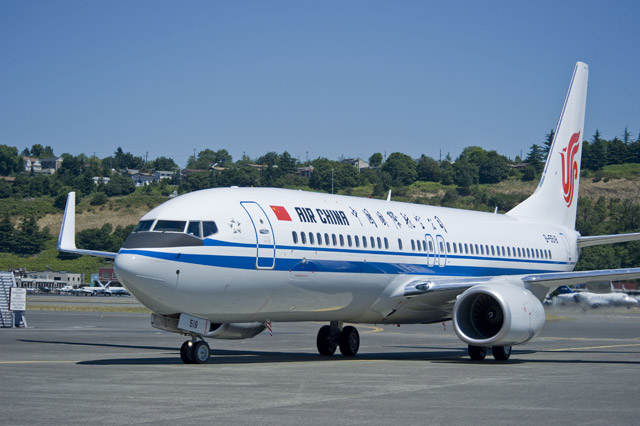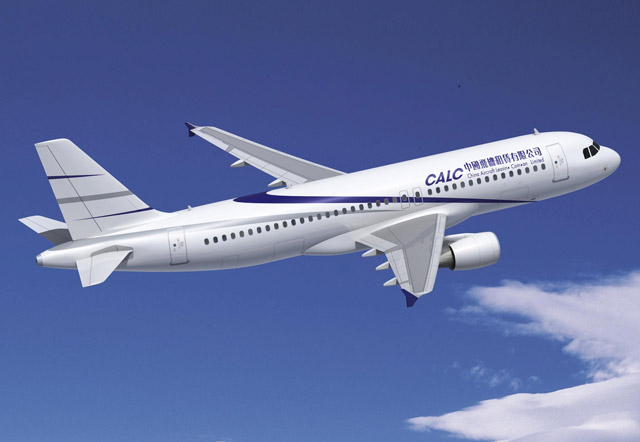For Boeing and Airbus, China is a market they both know that they cannot afford to lose, or even loosen their grip on. For both heavyweights, China is set to be the second-largest market outside the USA. Flightglobal's Ascend Online database reveals Chinese carriers operate 846 and 830 Boeing and Airbus aircraft respectively. As China develops, numbers will only increase.
Boeing forecasts China will need 5,260 commercial jets worth $670 billion in the next 20 years, where 75% will be for fleet growth instead of replacement. During the next 10 years, one out of every six aircraft that roll off Boeing's production lines will be delivered in China.
 |
|---|
| Boeing Last year, Air China received its first 737-800 with a Sky Interior |
Airbus, meanwhile, expects China to require 3,832 new passenger and freighter aircraft in the next 20 years - 2,520 narrowbodies, 1,084 widebodies and 228 very large aircraft. Right now, more than 20% of all newly-assembled Airbus aircraft are destined for China.
The giants will not have the market all to themselves, and both agree that home-grown manufacturer Comac will take a slice of the coveted Chinese pie. "We take it as a reality that the duopoly is over and that it's going to be a market of three OEMs," says Boeing China president Marc Allen.
"The arrival of a third manufacturer will scramble the field. The market share will shift; there is no doubt about it."
The good news, analysts say, is there is room for all three. "Even with the C919 in production, the Chinese market will absorb significant numbers of western narrowbodies for years to come," says Raymond Jaworowski, senior aerospace analyst at Forecast International.
Rookie Comac has already scored 330 orders for its narrowbody, mostly from Chinese airlines and leasing companies. Paul Sheridan, Ascend's head of consultancy in Asia, forecasts the C919 will have up to 80 deliveries a year by 2021, most of which will be for China.
SCORING ORDERS
The Ascend Online database shows that between 2007 and 2011, Airbus and Boeing delivered an average of 73 and 60 aircraft a year respectively to China.
"These numbers should grow over the next 10 years, but it shows that the C919 has the potential to achieve a similar market in China as the Boeing 737 and Airbus A320," says Sheridan. "Boeing and Airbus will want to ensure that this does not spread to any other countries."
With the C919 on the horizon, Boeing and Airbus are battling to convince Chinese carriers and lessors to continue on with them to their re-engined Max and Neo.
Airbus scored first in August with its inaugural Chinese Neo order, when ICBC Leasing inked an agreement for 20 A320neos and 30 A320s. Fabrice Brégier, Airbus chief executive, expects more orders to roll in before the year ends, and is targeting to grow market share in China to above 50%. He claims the Neo "is much better than its competitors".
"The C919 will find its way into the Chinese market - this is clear," he says. "But the Chinese airlines have been using the A320 and the 737, which are good aircraft. They will also possibly move to the Neo and the Max. This will require Comac to develop a competitive, reliable aircraft and once they do, they will have a premium on the Chinese market."
Allen is quick to point out that although no Chinese Max sales have been closed, it does not mean discussions are not ongoing. "It's going to be a dogfight all the way through," he says. "We're in the midst of a dynamic point because of the Neo and Max. What's going to happen in the next couple of years is, you'll see airlines' interest in the Max becoming an overwhelming part of the story line. You'll see a lot of Chinese airlines being very early in the Max delivery line up."
Boeing is also confident its 787 and 777-300ER will take a leadership position in China's widebody market. It expects more orders for the 787 to come as the aircraft starts flying in the country. China Southern Airlines is on track to take delivery of its first Dreamliner this year, assures Allen.
SIZING UP
Airbus, meanwhile, is certain the A320 and A330 will continue to serve the market well. Sales for its A350 and A320neo should also pick up when China announces its 13th five-year plan. "Because of airport constraints, for example, between Beijing and Shanghai, there will be a move from single- to double-aisle aircraft," says Laurence Barron, president of Airbus China.
When asked about the Airbus A380, which has so far only garnered one order for five aircraft from China Southern, Brégier says: "We expect the Chinese market to be a huge A380 market, probably the biggest in the world. But this will take time."
Boeing disagrees, saying the superjumbo is "too large" to have a strong presence in many markets. "Ultimately, the A380 is a plane that fits just a very small number of routes. So as our 747-8s arrive, we think we'll have a better-sized airplane at the jumbo level," says Allen.
With regard to A320 sales, Airbus believes its decision to set up an A320 final assembly line in Tianjin, its first outside Europe, has certainly accelerated its growth in China.
 |
|---|
| Airbus In July, China Aircraft Leasing Company committed to 36 current-generation A320s |
"When we started in 2005, there were questions of whether it would work. After seven years, now we see the strategy really paying off," says Brégier, adding that its market share in China has grown by about 20% since it set up shop in Tianjin.
Airbus has also negotiated an extension of its Tianjin assembly line, signing a framework agreement with state-owned airframer AVIC and the Tianjin Free Trade Zone to continue manufacturing A320s in Tianjin beyond the previously-contracted 2016.
Details of the 10-year contract extension will be firmed by mid-2013. Brégier also confirms the Tianjin line will produce the A320neo - after its Hamburg and Toulouse facilities. Airbus has 430 employees on the Tianjin line and 1,200 in China.
Airbus's China efforts, however, have been rendered "more complex" as a result of the EU's Emissions Trading System (ETS), says Brégier. Approval for $12 billion of Airbus widebody orders remains suspended as China continues retaliation against the ETS, although narrowbody sales for domestic and regional use have not been affected.
Boeing has no immediate plans to start an assembly line in China. Rather, to maintain its dominant position, it will focus on innovation to ensure it has an efficient aircraft in every class.
Boeing has about 2,000 staff in China right now - from those in its corporate office to those at Boeing Tianjin Composites. China builds various parts including horizontal stabilizers, vertical fins, the aft tail section, doors and rudders for several Boeing aircraft including the 787.
The US airframer is also collaborating with Comac by supporting research to improve aviation and industry fuel efficiency, while reducing its environmental footprint.
"We believe it's essential and unavoidable that we both compete and collaborate to create technology together to make each of us more successful," says Boeing's Allen.
"We hope that by doing so, as airplane growth matures, Comac will steal a share from Airbus. That's the perfect outcome."
Source: Flight International
















